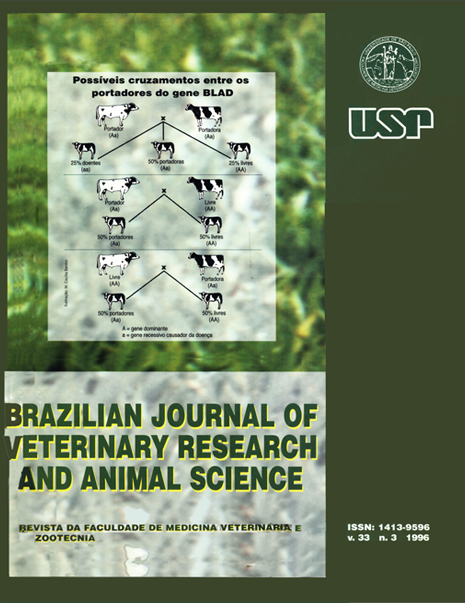Possible association between hemoglobin types and reproductive disorders in Brazilian Mangalarga mares
DOI:
https://doi.org/10.11606/issn.2318-3659.v33i3p176-180Keywords:
Hemoglobin, Electrophoresis, Mares.Abstract
In the present report the biochemical polymorphism of Mangalarga mares hemoglobin, in reproductive age, from Santa Fé Farm, Botucatu, São Paulo, was studied. Animals were classified in two groups, according to reproductive history of each mare; the first group was performed by normal mares (control group) and the second one by animals with reproductive disorders (barren mares). From each animal, around 15 ml of vessel blood were collected. Hemoglobins were typed by polyacrylamide gel electrophoresis, 7% of concentration in the resolving gel, in a discontinuous alkaline (pH 8.6) buffer system. The following hemoglobins phenotypes were found in the control group, with the respective frequencies:A¹--- (2,0%), A¹, A²m+m+ (21,0%) e A¹A² m+m (27,0%). To the group performed by reproductive disorders carrier animals the following results were obtained : A¹--- (10,0%), A¹A² m+m+ (12,0%) e A¹A²m+m+ (28,0%). The difference observed in the A¹--- phenotype between the groups may be due to a probable liaison with hemoglobin locus and another one related with reproductive traits. Besides this fact, tropical environment effects may be acting on this locus, thus leading to obtained resultsDownloads
Download data is not yet available.
Downloads
Published
1996-09-01
Issue
Section
ANIMAL PATHOLOGY
License
The journal content is authorized under the Creative Commons BY-NC-SA license (summary of the license: https://
How to Cite
1.
Lima e Silva R de, Ramos PRRR, Almeida MRH de, Bortolozzi J, Martins Junior A, Bruder EM. Possible association between hemoglobin types and reproductive disorders in Brazilian Mangalarga mares. Braz. J. Vet. Res. Anim. Sci. [Internet]. 1996 Sep. 1 [cited 2026 Jan. 18];33(3):176-80. Available from: https://revistas.usp.br/bjvras/article/view/50188





